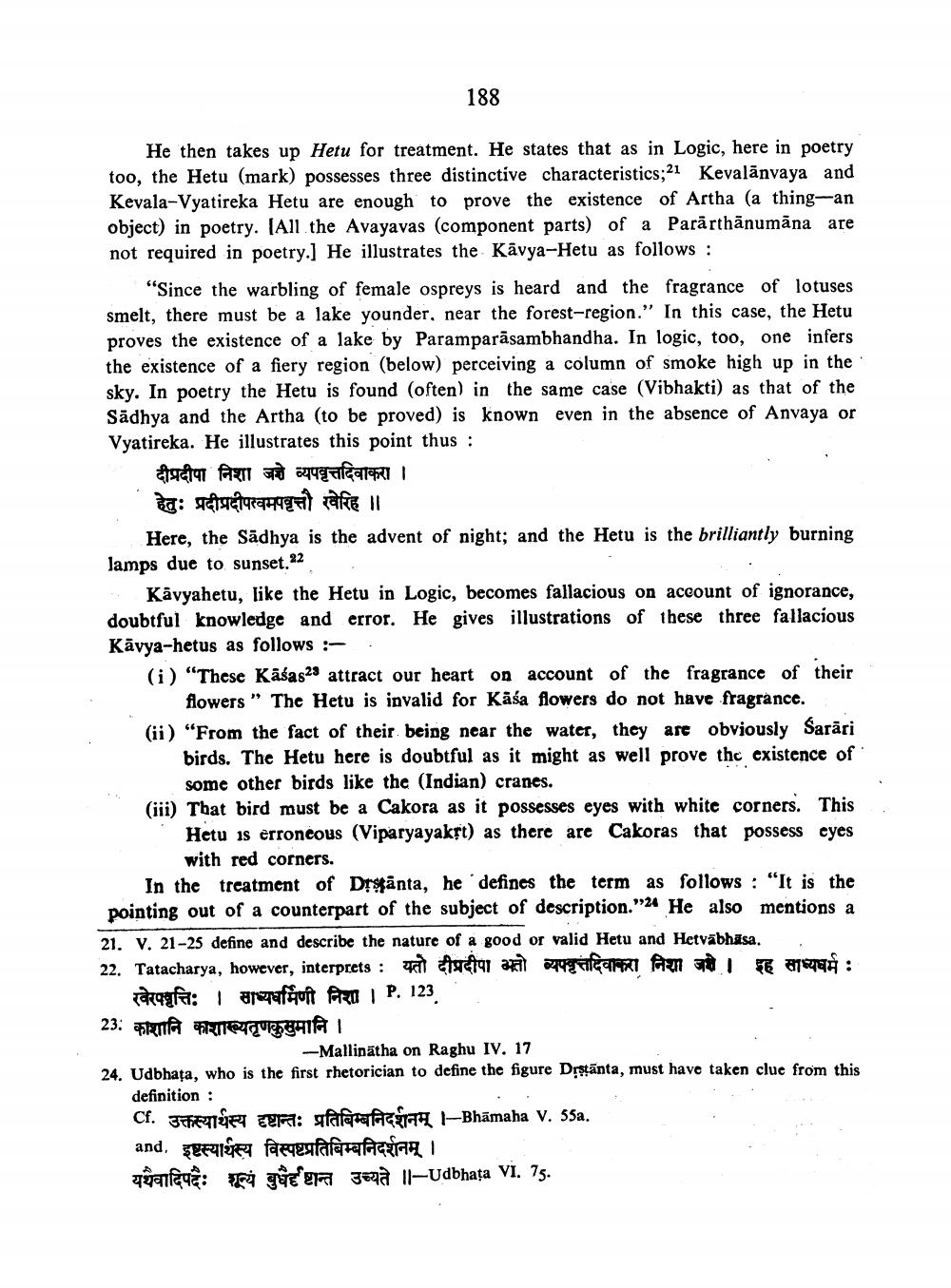________________
188
He then takes up Hetu for treatment. He states that as in Logic, here in poetry too, the Hetu (mark) possesses three distinctive characteristics;21 Kevalänvaya and Kevala-Vyatireka Hetu are enough to prove the existence of Artha (a thing-an object) in poetry. [All the Avayavas (component parts) of a Pararthänumāna are not required in poetry.] He illustrates the Kavya-Hetu as follows:
"Since the warbling of female ospreys is heard and the fragrance of lotuses smelt, there must be a lake younder, near the forest-region." In this case, the Hetu proves the existence of a lake by Paramparasambhandha. In logic, too, one infers the existence of a fiery region (below) perceiving a column of smoke high up in the sky. In poetry the Hetu is found (often) in the same case (Vibhakti) as that of the Sadhya and the Artha (to be proved) is known even in the absence of Anvaya or Vyatireka. He illustrates this point thus:
दीप्रदीपा निशा जज्ञे व्यपवृत्तदिवाकरा ।
हेतुः प्रदीप्रदीपत्वमपत्ती खेरिह ||
Here, the Sadhya is the advent of night; and the Hetu is the brilliantly burning lamps due to sunset.22
Kavyahetu, like the Hetu in Logic, becomes fallacious on account of ignorance, doubtful knowledge and error. He gives illustrations of these three fallacious Kavya-hetus as follows:
(i) "These Kasas29 attract our heart on account of the fragrance of their flowers" The Hetu is invalid for Käsa flowers do not have fragrance.
(ii) "From the fact of their being near the water, they are obviously Sarari
birds. The Hetu here is doubtful as it might as well prove the existence of some other birds like the (Indian) cranes.
(iii) That bird must be a Cakora as it possesses eyes with white corners. This Hetu is erroneous (Viparyayakṛt) as there are Cakoras that possess eyes with red corners.
In the treatment of Drstanta, he defines the term as follows: "It is the pointing out of a counterpart of the subject of description."24 He also mentions a 21. V. 21-25 define and describe the nature of a good or valid Hetu and Hetvābhāsa. 22. Tatacharya, however, interprets: यतो दीप्रदीपा भतो व्यपवृत्तदिवाकरा निशा जशे । इह साध्यधर्म : वेरपवृत्तिः । साध्यधर्मिणी निशा । P. 123,
23. काशानि काशास्यतृणकुसुमानि ।
-Mallinatha on Raghu IV. 17
24. Udbhata, who is the first rhetorician to define the figure Drstanta, must have taken clue from this definition :
Cr. उक्तस्वार्थस्य दृष्टान्तः प्रतिविम्बनिदर्शनम् - Bhāmaha V. 55.
and इष्टस्यार्थस्य विस्पष्टप्रतिबिम्बनिदर्शनम् ।
यथैवादिपदः शून्यं बुधे शन्त उभ्यते || Udbhata VI. 75.




